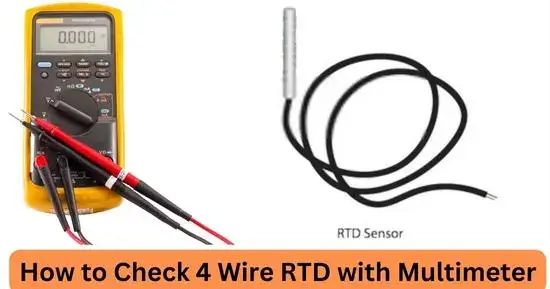In this article, you will learn how to check a 4 wire RTD with a multimeter. We provide easy-to-follow instructions to ensure you get accurate temperature readings and troubleshoot any issues with your RTD. This guide is ideal for engineers, technicians, and anyone working with temperature sensors.
RTD (Resistance Temperature Detector) is a tool or a device that correlates the temperature and resistance. These devices are installed at different places to detect temperature changes. Check and maintenance of these devices is essential because if they start giving faulty results, this problem can cause significant problems for you depending upon the purpose and sensitivity of the place where they are installed.
Table of Contents
ToggleWhat is RTD?
RTD is a device that helps detect a minute to a big temperature change. The type of signal in which the RTD shows the temperature change is a change in resistance. The resistance of the component changes with the change in its temperature. In this way, RTD tells us about the increase and decrease in the temperature of any of our devices. According to the results, we take specific precautions.
Now the parameters at which the RTD will work differ from place to place where they are installed and according to the type of work in the device. So the results that an RTD shows also change according to the type of device.
Types of RTD:
The types of RTD differ based on the number of wires that come with the RTD. Different kinds of RTD are used in various places according to the extent of their results. So the types of RTD are the following:
-
2-Wire RTD
They are used at places where the only aim is to detect the temperature change, but no precise value is needed. So at that place, the two wire RTDs are installed.
So you cannot use these types of RTD at the place where you want to know the precise value of the temperature change and where a 1-degree change can lead to a big problem. Here the lead wire resistance is undetectable from the sensor measurement.
-
3-Wire RTD
A 3-wire RTD comes with three wires, and their preciseness increases as the number of wires with the RTD increases. These types of RTD are used in industries where a limited, precise temperature change value is required. As this RTD contains three wires, one wire gives a chance to detach the lead wire resistance from the sensor measurement.
The RTD with three wires is used to save money by spending money on the four wires at a place where a little Misinterpretation is not a big deal.
-
4-wire RTD
is the best type as it provides 100% precise value in the result. These types of RTD are mostly used in laboratories where the whole procedure is conducted precisely and controlled. The four-wire RTD is more expensive than the other types of RTD.
Now if you are opting to use a four-wire RTD, you should know exactly the working procedure of the four-wire RTD if any problem occurs in the 4 why RTD, you should know how to check to see the root cause of the situation.
Working of 4-wire RTD
Four wires in a 4-wire RTD are installed in a circuit together in which all these four wires have specific work to do. Wire number 1 and 4 gives the energy to the circuit, and wire number 2 and 3 reads the change. This setup acts like a bridge; in this way, any small change in the temperature is detected easily with the help of the four wires.
But if any of these four wires got some issues, they can lead to erroneous results. In this way, it is necessary to check the four-wire RTD so that you can understand the problem in the 4-wire RTD. Then you can decide whether to change any wires setup in the RTD or install the whole device completely new.
How to check 4 wire RTD with a multimeter?
The digital multimeter is the best tool to check a 4 wire artery because it helps you quickly narrow the artery without arranging much to send materials for the test. You will get precise results in the end, so it will be easy to understand the root cause of the problem if you use the digital multimeter for this purpose.
Tools required:
- Digital Multimeter
- Protection gloves
How to check 4 wire RTD with a multimeter (step-by-step guide)
Here is the step-by-step guide to checking the 4 wire RTD:
Step 1: Identify the type of RTD
As you will check the 4-wire RTD, you should know the type of the 4-wire RTD as we understand that these RTDs are made up of platinum. They all have different resistance values ranging from 100 to 1000 ohms. So your 4-wire RTD may be one of the pt100, pt1000, or pt500 4-wire RTD.
So it is essential to identify the type of RTD you will check using the digital multimeter. Then you have to download the resistance table of your type of RTD from which you will understand the standard temperature at specific resistance values. It will make it easy to identify whether the fault is present in your RTD.
Step 2: Set the digital multimeter
You will use the digital multimeter to check the 4 wire RTD. You have to set the digital multimeter at the resistance settings. For this, you have to turn the selection knob of the digital multimeter towards the resistance symbol ohms. Now the digital multimeter is ready for you to check the 4 wire RTD.
Step 3: Connect the leads
Take the hook leads of the digital multimeter and connect them with the points of two different colors of the RTD. Don’t connect the leads with the two consecutive points because you need to connect the leads with the same color jacks to get the exact resulting value of the resistance.
Step 4: Take the results
Take the resistance readings, which you will see on the digital screen of the multimeter. A normal 4-wire RTD will show zero to 1-ohm results. If more than 1 reading comes in the result, then this is an indication of faulty RTD.
Step 5: Take readings at room temperature
Now you have to take the reading for the second time. This time, you must do this at room temperature by measuring the resistance across the element. You should get the resulting reading around 100 to 120 ohms, indicating a well working 4 wire RTD.
Step 6: Take the third reading
Now you have to take a third resistance reading. This time you have to connect the jump lead at the positive terminal of the connector and then measure the resistance across the element. If you get the resulting reading around 109 ohms, then this indicates a healthy 4-wire RTD. Still, the readings alternative to this normal reading will show a faulty 4-wire RTD for which you must buy a new 4-wire RTD.
Benefits of using 4-wire RTD
Although there are different 2 and 3-wire RTDs also available in the market, which are pretty cheap in contrast with the 4-wire RTD. But still, the 4 wire RTD has some benefits over these 2 or 3-wire RTDs, which are given following:
- You will get more precise results
- 4 wire RTD has a good quality
- They are highly sensitive but are beneficial for labs and research centers
- Can measure the temperature differences at a big range.
Final verdict
RTDs have different benefits because they are installed with many appliances, especially in research centers and industries. They provide brief knowledge about the change in the temperature of the instruments. Depending upon those instructions, you take your next steps.
If the 4-wire RTD stops giving you precise results, then this is a clear sign of some issues, which you can check with the help of a digital multimeter. By measuring the resistance of different terminals of the 4-wire RTD, you know which part of the 4 wire RTD has problems.
Then the person with a brief knowledge of the 4-wire RTD will decide whether to repair the 4-wire RTD or replace it with the new one. Still, before this, proper testing guidance is also required. So by following the given information, you will make your final decision quickly.
More Guides:




